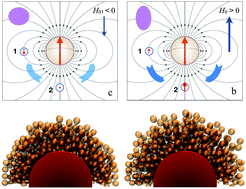Modeling the magnetostriction effect in elastomers with magnetically soft and hard particles†
Abstract
We analyze theoretically the field-induced microstructural deformations in a hybrid elastomer, that consists of a polymer matrix filled with a mixture of magnetically soft and magnetically hard spherical microparticles. These composites were introduced recently in order to obtain a material that allows the tuning of its properties by both, magnetically active and passive control. Our theoretical analysis puts forward two complementary models: a continuum magnetomechanical model and a bead-spring computer simulation model. We use both approaches to describe qualitatively the microstructural response of such elastomers to applied external fields, showing that the combination of magnetically soft and hard particles may lead to an unusual magnetostriction effect: either an elongation or a shrinking in the direction of the applied field depending on its magnitude. This behavior is observed for conditions (moderate particle densities, fields and deformations) under which the approximations of our models (linear response regime, negligible mutual magnetization between magnetically soft particles) are physically valid.



 Please wait while we load your content...
Please wait while we load your content...